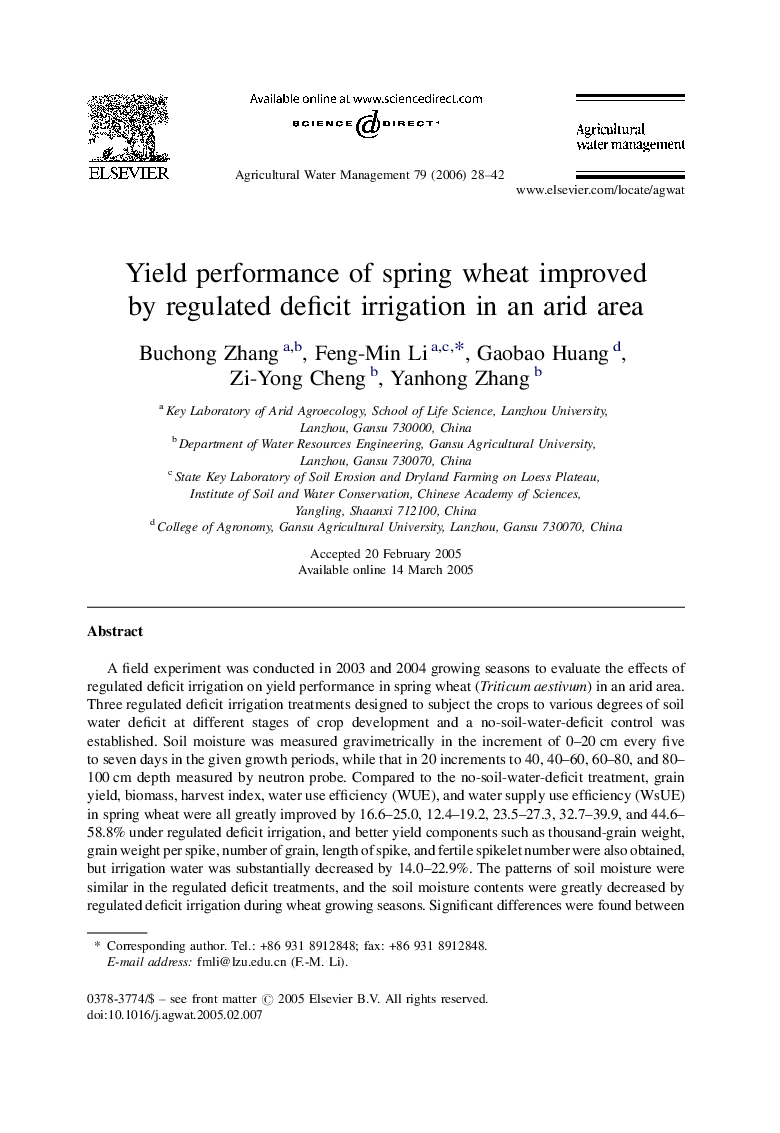| کد مقاله | کد نشریه | سال انتشار | مقاله انگلیسی | نسخه تمام متن |
|---|---|---|---|---|
| 4480656 | 1316511 | 2006 | 15 صفحه PDF | دانلود رایگان |

A field experiment was conducted in 2003 and 2004 growing seasons to evaluate the effects of regulated deficit irrigation on yield performance in spring wheat (Triticum aestivum) in an arid area. Three regulated deficit irrigation treatments designed to subject the crops to various degrees of soil water deficit at different stages of crop development and a no-soil-water-deficit control was established. Soil moisture was measured gravimetrically in the increment of 0–20 cm every five to seven days in the given growth periods, while that in 20 increments to 40, 40–60, 60–80, and 80–100 cm depth measured by neutron probe. Compared to the no-soil-water-deficit treatment, grain yield, biomass, harvest index, water use efficiency (WUE), and water supply use efficiency (WsUE) in spring wheat were all greatly improved by 16.6–25.0, 12.4–19.2, 23.5–27.3, 32.7–39.9, and 44.6–58.8% under regulated deficit irrigation, and better yield components such as thousand-grain weight, grain weight per spike, number of grain, length of spike, and fertile spikelet number were also obtained, but irrigation water was substantially decreased by 14.0–22.9%. The patterns of soil moisture were similar in the regulated deficit treatments, and the soil moisture contents were greatly decreased by regulated deficit irrigation during wheat growing seasons. Significant differences were found between the no-soil-water-deficit treatment and the regulated soil water deficit treatments in grain yield, yield components, biomass, harvest index, WUE, and WsUE, but no significant differences occurred within the regulated soil water deficit treatments. Yield performance proved that regulated deficit irrigation treatment subjected to medium soil water deficit both during the middle vegetative stage (jointing) and the late reproductive stages (filling and maturity or filling) while subjected to no-soil-water-deficit both during the late vegetative stage (booting) and the early reproductive stage (heading) (MNNM) had the highest yield increase of 25.0 and 14.0% of significant water-saving, therefore, the optimum controlled soil water deficit levels in this study should range 50–60% of field water capacity (FWC) at the middle vegetative growth period (jointing), and 65–70% of FWC at both of the late vegetative period (booting) and early reproductive period (heading) followed by 50–60% of FWC at the late reproductive periods (the end of filling or filling and maturity) in treatment MNNM, with the corresponding optimum total irrigation water of 338 mm. In addition, the relationships among grain yield, biomass, and harvest index, the relationship between grain yield and WUE, WsUE, and the relationship between harvest index and WUE, WsUE under regulated deficit irrigation were also estimated through linear or non-linear regression models, which indicate that the highest grain yield was associated with the maximum biomass, harvest index, and water supply use efficiency, but not with the highest water use efficiency, which was reached by appropriate controlling soil moisture content and water consumption. The relations also indicate that the harvest index was associated with the maximum biomass and water supply use efficiency, but not with the highest water use efficiency.
Journal: Agricultural Water Management - Volume 79, Issue 1, 10 January 2006, Pages 28–42